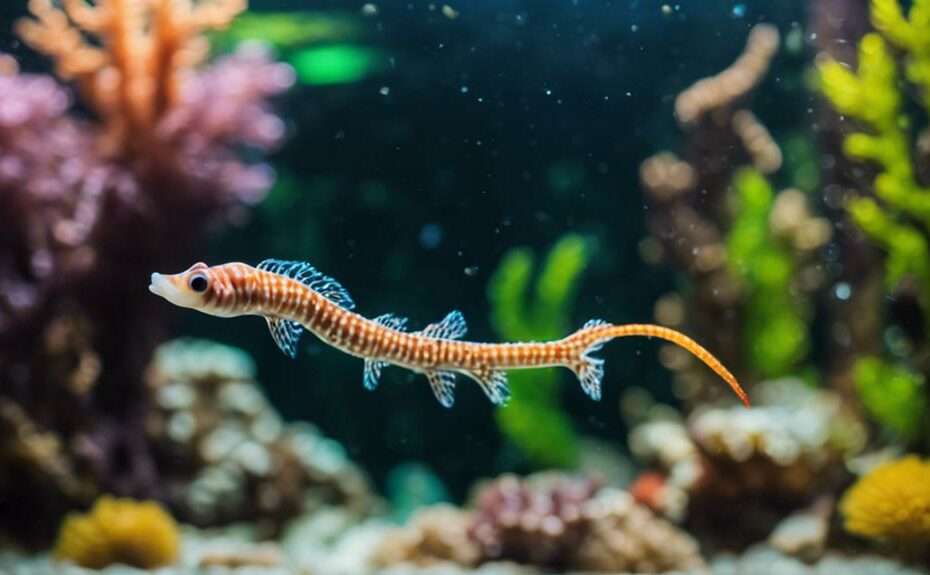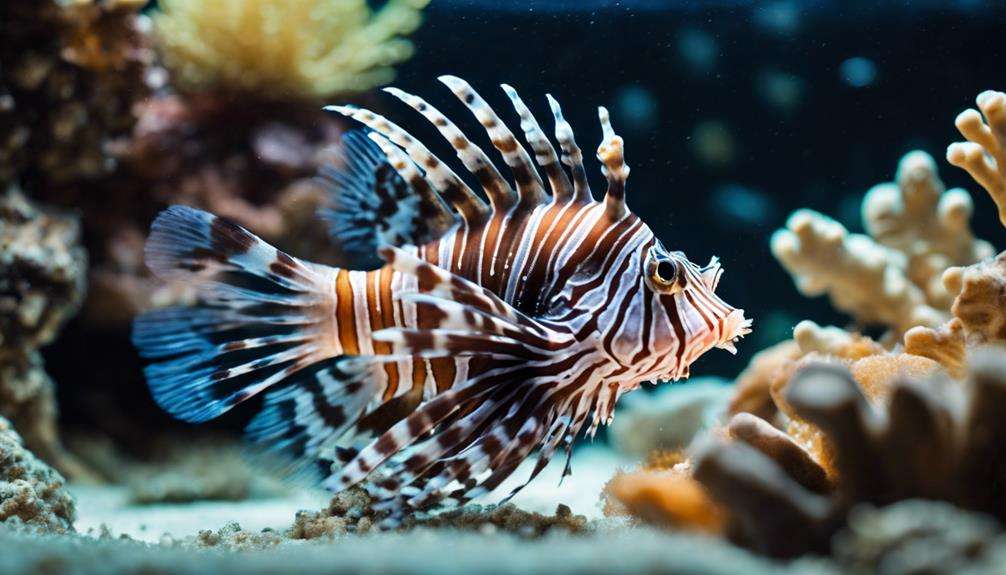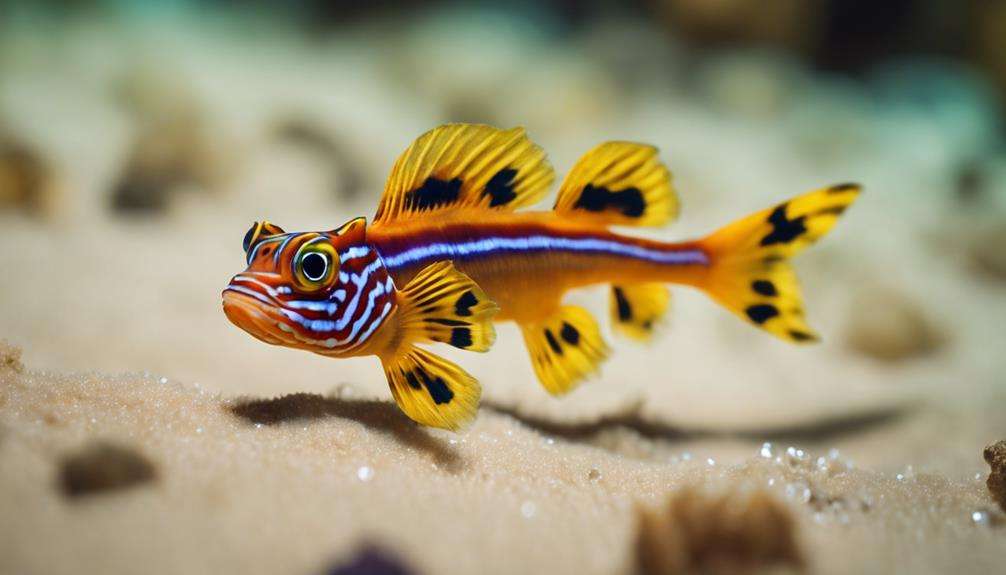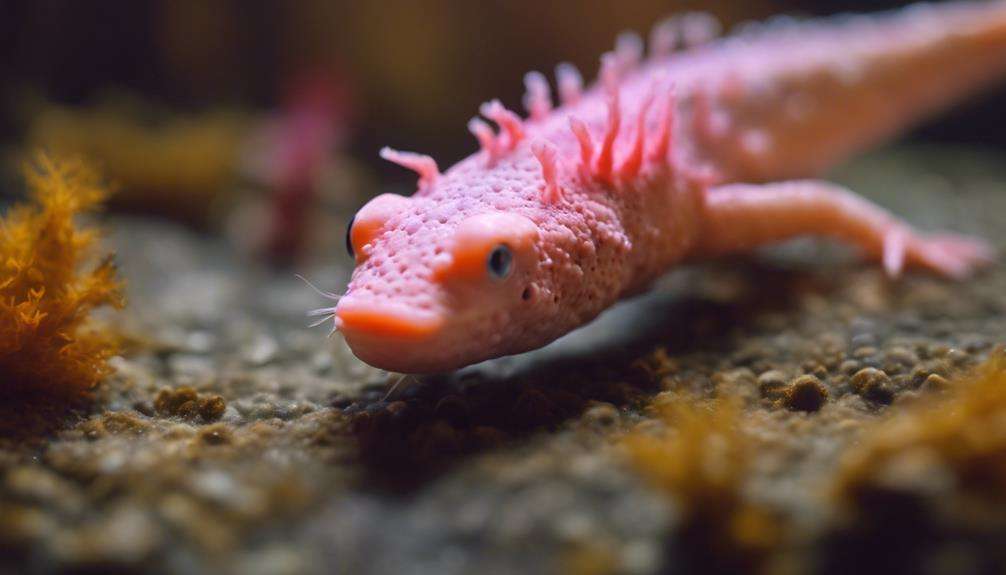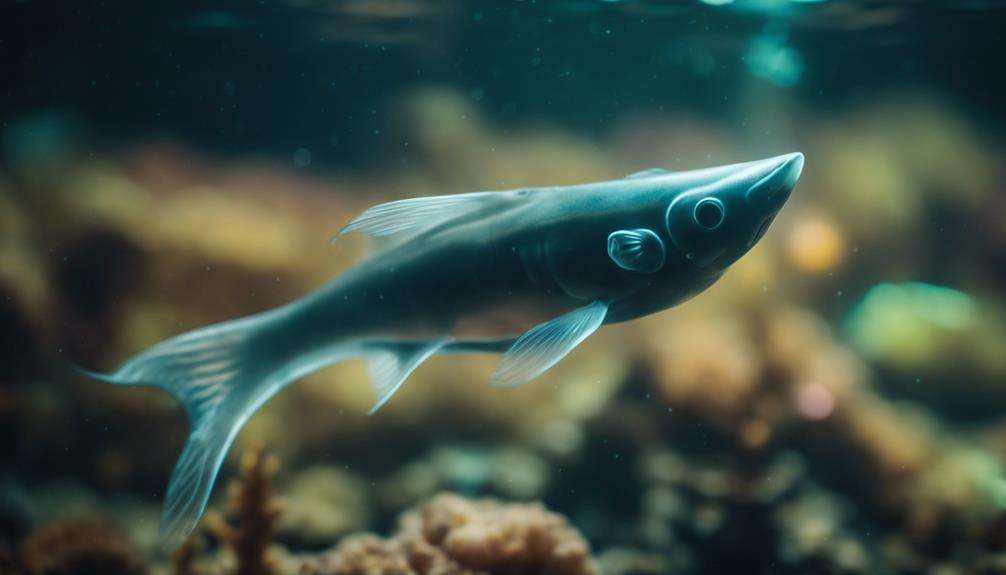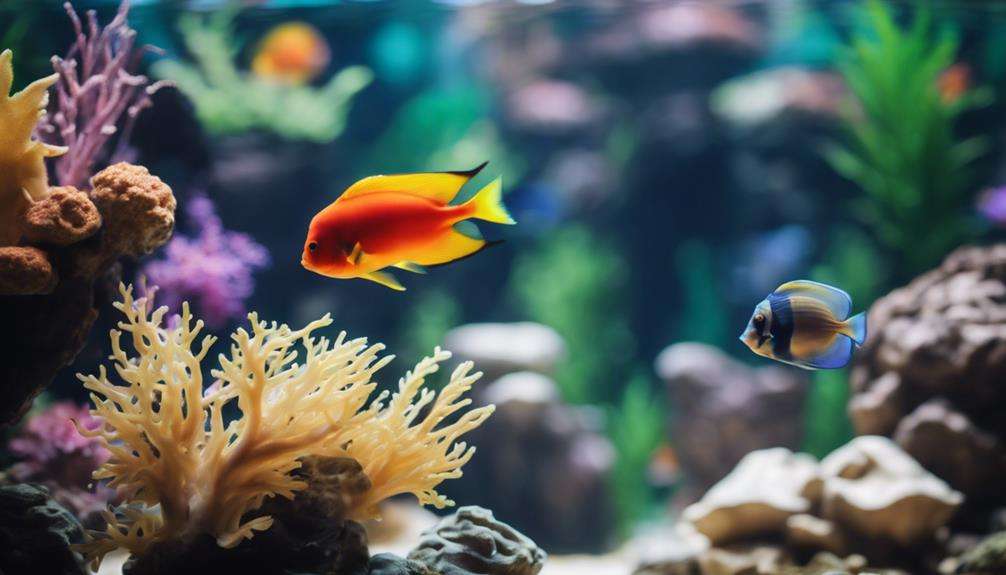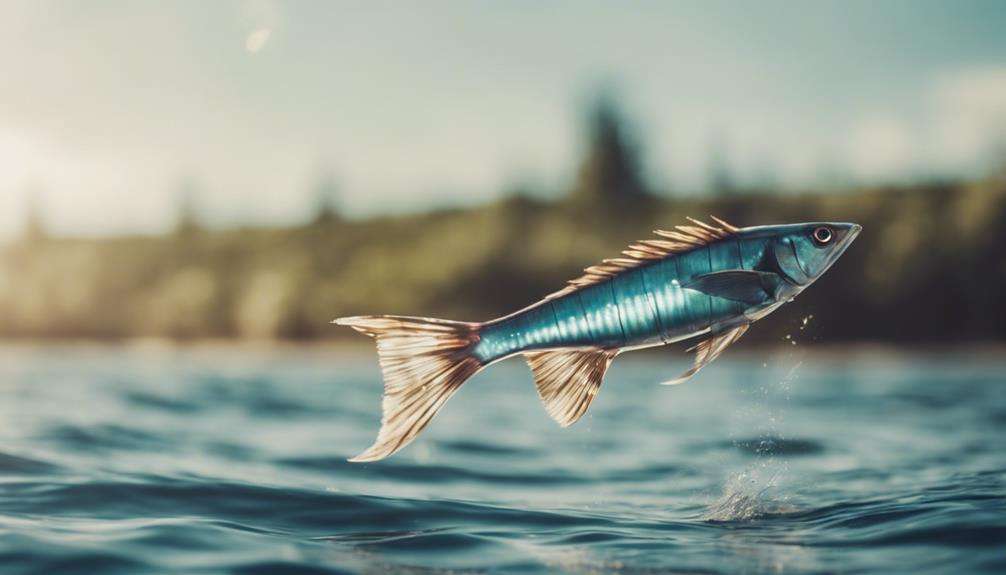When it comes to creating a harmonious environment for your pipefish tank, making thoughtful choices is essential. Ensuring the compatibility of tank mates and considering factors like water quality are paramount for their well-being.
However, there are additional nuances to explore that can elevate your pipefish care to the next level. By understanding the intricacies of their behavior and implementing specific strategies, you can truly optimize their habitat.
Stay tuned to unravel the intricacies of fostering a successful pipefish tank setup.
Key Takeaways
- Choose tank mates carefully to avoid aggression and territorial issues.
- Provide hiding spots for pipefish to feel secure and reduce stress.
- Monitor feeding behavior and adjust amounts accordingly for all pipefish.
- Consider tank size and layout to accommodate pipefish behavior and interactions with other tank inhabitants.
Tank Size and Setup
When setting up your pipefish tank, ensure a minimum size of 30 gallons per pair to allow ample swimming space in the reef aquarium. Pipefish, known for their slender bodies and small size, require vertical height of at least 24 inches in the tank setup to accommodate their natural behavior of swimming vertically. It's crucial to provide hiding spots such as rocks, grass, and caves within the tank for pipefish to feel secure and reduce stress. Additionally, incorporating live plants or artificial structures will offer anchor points for the pipefish to rest comfortably.
To create an ideal environment for pipefish, maintain proper water flow in the tank. Pipefish thrive in well-oxygenated waters, so ensuring adequate circulation will support their unique needs. By carefully planning your tank setup with attention to these details, you can provide a suitable habitat for pipefish to flourish in your home aquarium.
Water Parameters and Quality
To ensure the optimal health of your pipefish, it's crucial to maintain stable water parameters. Control the water temperature within the range of 72-77°F.
Keep pH levels between 8.1-8.4, and monitor nitrate and ammonia levels regularly.
Maintaining these parameters will mimic natural saltwater conditions and provide a safe environment for your pipefish.
Ph Levels Importance
Maintaining proper pH levels in your pipefish tank is crucial for ensuring the health and well-being of these marine creatures. Pipefish thrive in water with a pH range of 8.1-8.4, which replicates their natural marine environment. Fluctuations in pH can stress pipefish, making them more vulnerable to diseases and health issues.
Regular monitoring of pH levels and water quality is essential to maintain a stable and suitable environment for pipefish. Consistent pH levels play a significant role in preserving the overall health and vitality of pipefish, ultimately supporting their longevity in captivity.
Water Temperature Control
Proper regulation of water temperature is essential for maintaining optimal health and well-being of pipefish in your aquarium. Keep the water temperature stable between 72-77°F to ensure the comfort of your pipefish.
Use a reliable heater to control temperature fluctuations and prevent any sudden changes that could stress your pipefish. They're sensitive to variations, so it's crucial to monitor the water temperature regularly with a thermometer.
Nitrate and Ammonia Levels
Ensuring that nitrate and ammonia levels remain within acceptable ranges is crucial for maintaining a healthy aquatic environment for your pipefish. Keep nitrate levels below 20 ppm to prevent adverse effects on your pipefish.
Regularly monitor ammonia levels as elevated concentrations can be harmful, leading to stress, illness, and even death. To ensure the well-being of your pipefish, maintain stable water parameters through proper filtration and regular water testing.
High ammonia levels can compromise the health of your pipefish, making it imperative to address any spikes promptly. Implementing an efficient filtration system and conducting routine water tests are essential practices to control nitrate and ammonia levels, safeguarding the overall health of your pipefish in the aquarium.
Tank Mates and Compatibility
When selecting tank mates for seahorses, it's crucial to consider compatibility with their unique needs and behaviors. To ensure a harmonious aquatic environment, here are some key considerations:
- Choose Small Fish: Opt for peaceful and small fish species that won't outcompete or intimidate seahorses.
- Consider Cleaner Shrimp: Cleaner shrimp like Peppermint shrimp can be beneficial tank mates as they help keep the tank clean from parasites.
- Reef Tank Compatibility: When keeping seahorses in a reef tank, select corals that are seahorse-friendly and won't harm them.
- Avoid Incompatible Tank Mates: Stay clear of aggressive or large fish such as triggerfish, puffers, and sharks, as well as larger crabs that may pose a threat to seahorses.
Feeding Requirements and Strategies
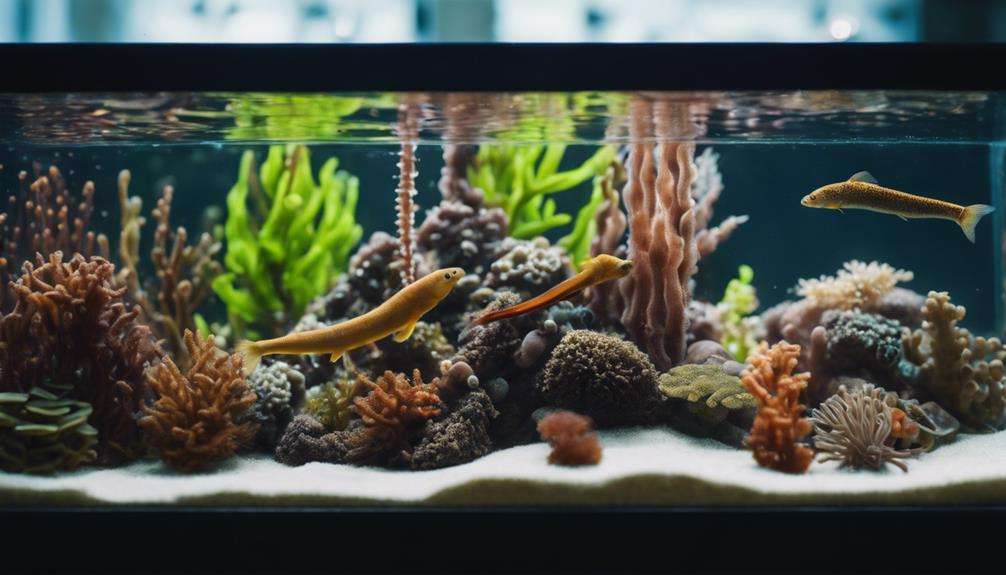
To ensure the optimal health of your pipefish, it's crucial to provide them with live foods enriched with essential fatty acids. Feeding your pipefish 2-3 times a day in small amounts is recommended, as they've a short digestive tract.
Good lighting is essential for these visual eaters to locate and consume their food effectively.
Feeding Time Schedule
How can you establish an effective feeding schedule for your pipefish to ensure optimal nutrition and health? When it comes to feeding time, here are some key tips to consider:
- Consistency is Key: Aim to feed small amounts multiple times a day to mimic their natural feeding behavior.
- Varied Diet: Provide a mix of live foods such as copepods and brine shrimp, along with enriched frozen foods to ensure a balanced diet.
- Monitor Closely: Keep a close eye on your pipefish during feeding to ensure they're actively eating and getting enough nutrition.
- Use Feeding Strategies: Employ tactics like target feeding and offering food at different tank levels to accommodate their feeding habits effectively.
Live Vs. Frozen
Establishing a feeding regimen that balances live and frozen food options is essential for meeting the nutritional requirements of pipefish in your tank. While live food like Brine Shrimp and Frozen mysis may offer more natural nutrients, frozen options can be enriched with essential vitamins and unsaturated fatty acids crucial for pipefish health.
Culturing live food can be challenging and may introduce parasites, whereas frozen food provides convenience and ease of portion control. Frozen food also has a longer shelf life, reducing the risk of spoilage compared to live alternatives.
Combining both live and frozen foods ensures a varied diet for your pipefish, promoting overall health and vitality. Consider incorporating tank-bred options to further minimize risks associated with live food sourcing.
Behavioral Observations and Adjustments
When observing pipefish behavior in your tank, it's crucial to pay close attention to signs of stress, aggression, or compatibility issues with other tank mates. To ensure a harmonious environment for your pipefish, consider the following behavioral observations and adjustments:
- Monitor Interactions: Watch how your pipefish interact with tank mates to identify any aggressive behavior or signs of stress.
- Create Territories: Adjust tank decorations and provide hiding spots to establish separate territories for pipefish, reducing territorial disputes.
- Introduce Slowly: When adding new tank mates, do so gradually and observe their interactions closely to ensure compatibility with the pipefish.
- Consider Feeding Habits: Take into account the feeding habits and activity levels of other tank mates to ensure they align with the unique needs of pipefish.
Breeding Considerations and Tips
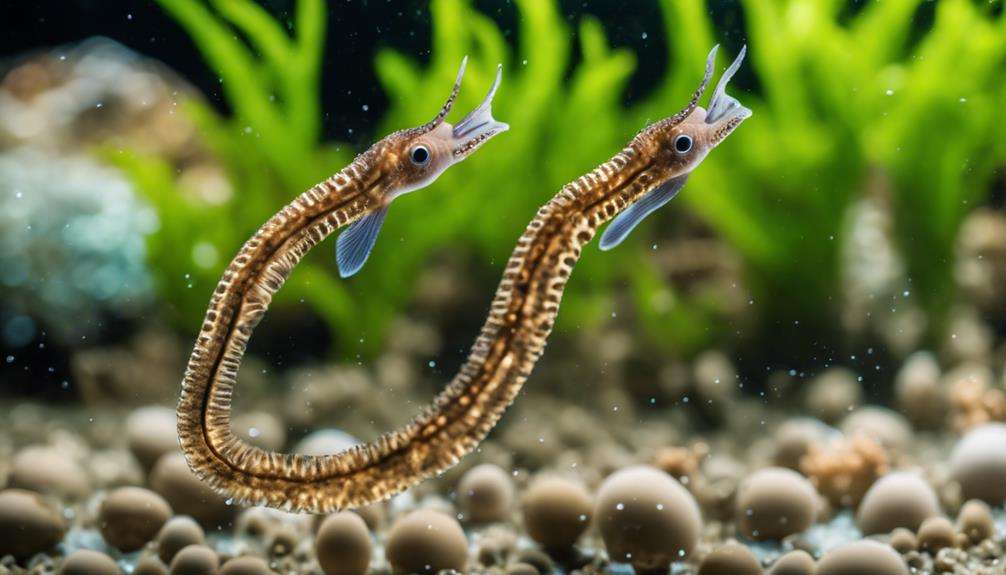
Breeding pipefish successfully requires careful attention to their unique courtship behaviors and specialized breeding conditions. Pipefish engage in elaborate courtship rituals such as dancing, color changes, and tail quivering to attract mates. During breeding, males receive eggs from females and carry them in a specialized pouch where fertilization and development take place. The gestation period varies among species, ranging from 10 days to several weeks. Once hatched, pipefish fry are independent but require tiny live foods for survival.
To increase breeding success, it's essential to provide specialized breeding tanks with controlled conditions. These tanks should offer ample hiding spots for fry to seek shelter and reduce stress. Maintaining water quality is crucial, as any fluctuations can impact breeding outcomes. Additionally, offering a variety of live foods will help nourish the developing fry and promote healthy growth. By creating a suitable environment that mimics their natural habitat and providing proper care, you can enhance the chances of successfully breeding pipefish in captivity.
Disease Prevention and Treatment
To safeguard the health of your pipefish, implementing effective disease prevention measures is crucial for maintaining a thriving aquatic environment. Here are four essential tips to help you prevent and treat diseases in your pipefish tank:
- Quarantine new pipefish: Always quarantine new additions to prevent the introduction of diseases into your main tank.
- Watch for signs of illness: Keep a close eye on your pipefish for signs of illness such as loss of appetite, abnormal swimming behavior, or lesions.
- Treat bacterial infections: If bacterial infections occur, promptly treat them with antibiotics in a separate quarantine tank to prevent spreading to other tank inhabitants.
- Maintain water quality and a stress-free environment: Ensure good water quality through regular testing and maintenance. Create a stress-free environment by providing suitable hiding spots and minimizing disturbances to prevent disease outbreaks.
Frequently Asked Questions
What Can Live With Pipefish?
Seahorses and pipefish make great tank mates due to their similar needs. Gobies and pipefish coexist peacefully. Shrimp and pipefish can share a habitat. Clownfish and pipefish are compatible. Anemones and pipefish can live together successfully.
Can You Keep Different Types of Pipefish Together?
Yes, you can keep different types of pipefish together, but be cautious. Consider pipefish social behavior, color variations, feeding habits, breeding challenges, and tank decorations. Monitor interactions closely, provide ample hiding spots, and separate feeding areas if needed.
What Size Tank Does a Pipefish Need?
For pipefish, a tank size of at least 30 gallons is needed to provide ample swimming space and mimic their natural habitats. A taller tank with a minimum height of 24 inches is recommended to accommodate their vertical swimming behavior.
What Are Pipefish Great At?
You might wonder what makes pipefish so extraordinary. Their exceptional feeding habits, intricate reproduction process, specific habitat preferences, unique behavioral traits, and ingenious predator avoidance tactics all contribute to their greatness in the marine world.
Conclusion
To ensure the success of your pipefish tank, remember that proper tank maintenance is crucial. Despite the additional effort required, regular water changes and cleaning routines are essential for the health and well-being of your pipefish.
While it may seem tedious, these tasks are necessary to prevent disease outbreaks and maintain optimal water quality for your unique aquatic pets. Stay diligent and committed to providing a clean and healthy environment for your pipefish to thrive.
